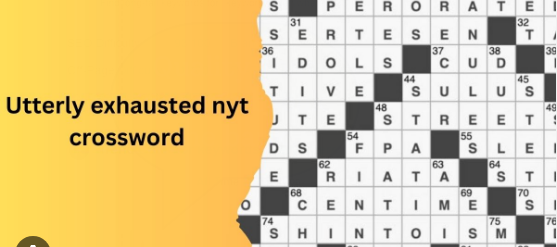Introduction to the New York Times Crossword Puzzle
Are you ready to embark on a mental marathon that will leave you utterly exhausted yet satisfyingly challenged? If so, the New York Times Crossword Puzzle is your ultimate destination! This iconic puzzle has puzzled and delighted crossword enthusiasts for decades, testing their wit and wordplay skills. Join us as we dive into the world of the NYT Crossword and explore tips, tricks, and strategies to conquer this brain-teasing behemoth. Let’s unlock the mysteries behind those black-and-white squares together!
The History and Popularity of utterly exhausted nyt crossword
Let’s take a trip down memory lane to explore the captivating history of crossword puzzles. They first emerged in the late 19th century, but it wasn’t until Arthur Wynne created the modern version in 1913 that they gained popularity. Since then, crossword puzzles have become a beloved pastime for people of all ages and backgrounds.
The appeal of utterly exhausted nyt crossword lies in their ability to challenge and entertain simultaneously. Whether you’re a casual solver or a dedicated enthusiast, there’s something irresistible about filling in those blank squares with the right words.
Over time, crossword puzzles have evolved to incorporate diverse themes and clever wordplay. From cryptic clues to playful puns, solving a crossword is like unraveling a linguistic puzzle where each answer unlocks another piece of the grid.
Today, with online platforms offering endless variations and difficulty levels, crossword puzzles continue to reign as one of the most enduring forms of mental exercise and entertainment.
Tips for Solving the NYT Crossword
Are you feeling utterly exhausted by the challenging clues of the utterly exhausted nyt crossword Puzzle? Fear not, as I’ve got some tips to help you conquer it like a pro!
Start with the easy clues. Don’t get overwhelmed by the difficult ones right away. Building momentum is key.
Use pencil lightly when filling in answers; this allows for easier corrections if needed later on.
Consider tackling one section at a time rather than jumping around randomly. It can help you see connections between different parts of the puzzle.
Don’t be afraid to skip a tricky clue and come back to it later. Sometimes fresh eyes can make all the difference in solving a stubborn word or phrase.
And lastly, don’t forget to take breaks! Giving your brain a rest can actually boost your problem-solving skills when you return to the puzzle.
Common Themes and Clues in the NYT Crossword
Crossword enthusiasts diving into the New York Times puzzle often encounter common themes and clues that add a layer of fun and challenge to their solving experience. Themes can range from wordplay, puns, historical references, to pop culture nods – keeping solvers on their toes with each grid’s unique twist.
Clues in the NYT Crossword vary in difficulty and creativity; some may be straightforward synonyms while others require more lateral thinking or knowledge of obscure trivia. From classic crossword staples like “river in Egypt” for NILE to contemporary references like “Taylor Swift hit song” for SHAKEITOFF, every clue is designed to test your wit and broaden your mental horizons.
Spotting recurring themes or recognizing familiar clues can sometimes give solvers a slight edge when tackling particularly tricky puzzles. Whether it’s deciphering anagrams or cracking cryptic riddles, mastering these common elements adds depth and enjoyment to the crossword-solving journey.
Strategies for Tackling an
When it comes to tackling the New York Times Crossword, having a few strategies up your sleeve can make all the difference. One approach is to start with the easier clues; this builds momentum and helps fill in some initial answers quickly. Another tip is to look for common crossword patterns like three-letter words often being “end” or “eel.” Don’t get stuck on one clue—move on and come back later if needed. It’s also helpful to keep a crossword dictionary handy for those tricky words that pop up frequently.
Consider working from different areas of the puzzle simultaneously instead of going linearly across or down. This method can help you solve interconnected words more efficiently. And don’t forget about theme hints! If you spot repeated themes or keywords, they might point you towards related answers throughout the grid.
Remember, solving a crossword is as much about creativity and lateral thinking as it is about vocabulary knowledge. So stay flexible in your approach and enjoy the challenge!
Alternative Ways to Enjoy the NYT Crossword Puzzle
Looking for a fresh twist on your NYT Crossword experience? How about collaborating with friends or family members to solve the puzzle together? It can spark lively discussions and add a fun social element to your solving routine.
Another alternative way to enjoy the crossword is by setting time limits for yourself. Challenge your speed-solving skills and see how quickly you can complete the puzzle. It adds an extra layer of excitement and competition to your solving session.
If you’re feeling artistic, try creating crossword-themed doodles or sketches as you work through the clues. Get creative with visual interpretations of words or themes from the puzzle – it’s a unique way to engage both hemispheres of your brain while having some doodling fun.
Feeling tech-savvy? Explore digital versions of the NYT Crossword that offer additional features like hint options, timers, and even interactive puzzles that adapt to your skill level. Embrace technology to enhance your puzzling experience in new ways!
Conclusion: Keep Exercising Your Brain with the NYT Crossword
The New York Times Crossword Puzzle is not just a game; it’s an exercise for your brain. With its long history and widespread popularity, solving the NYT crossword can provide mental stimulation and entertainment at the same time. By engaging with challenging clues and themes, you are keeping your mind sharp and expanding your vocabulary.
So, whether you’re a seasoned solver or just starting out, make solving the NYT crossword a regular part of your routine. Challenge yourself to think outside the box, learn new words, and improve your problem-solving skills. The feeling of satisfaction when you finally fill in that last square after being utterly exhausted is truly rewarding.
Embrace the mental workout that comes with each puzzle and enjoy the journey of unraveling those tricky clues. Keep exercising your brain with the NYT Crossword – it’s a fun way to stay sharp!










